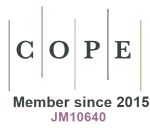PIVKA-II or AFP has better diagnostic properties for hepatocellular carcinoma diagnosis in high-risk patients
DOI:
https://doi.org/10.33393/jcb.2023.2453Keywords:
Hepatitis B virus, Hepatitis C virus, Sensitivity, SpecificityAbstract
Background: Hepatocellular carcinoma (HCC) is a lethal cancer. Two biomarkers were used for HCC diagnosis including alpha-fetoprotein (AFP) and protein induced by vitamin K absence-II or antagonist (PIVKA-II). However, data on biomarkers and HCC diagnosis are not consistent. This study aimed to evaluate if PIVKA-II, AFP, or a combination of both biomarkers had the best diagnostic properties for HCC.
Methods: This was a prospective study and enrolled patients 18 years or over with a high risk for HCC. AFP and PIVKA-II levels were calculated for HCC diagnosis. Diagnostic properties of both biomarkers were reported with sensitivity, specificity, and a receiver operating characteristic (ROC) curve.
Results: There were 260 patients with high risk for HCC in this cohort. Of those, 219 patients were diagnosed with HCC: confirmed by biopsy in 7 patients (2.69%) and by imaging in the others. Median values of AFP and PIVKA-II were 56 ng/mL and 348 mAU/mL, respectively. PIVKA-II level of 40 mAU/mL had sensitivity of 80.80%, while AFP of 10 ng/mL had sensitivity of 75.80%. A combination of PIVKA-II at 100 mAU/mL or over and AFP of 11 ng/mL gave sensitivity of 60.30%. The ROC curve of PIVKA-II plus AFP was significantly higher than the AFP alone (0.855 vs. 0.796; p = 0.027), but not significantly different from the PIVKA-II alone (0.855 vs. 0.832; p = 0.130).
Conclusion: PIVKA-II may have more diagnostic yield for HCC compared with AFP. It can be used alone without a combination with AFP.
References
- Akinyemiju T, Abera S, Ahmed M, et al; Global Burden of Disease Liver Cancer Collaboration. The burden of primary liver cancer and underlying etiologies from 1990 to 2015 at the global, regional, and national level: results from the Global Burden of Disease Study 2015. JAMA Oncol. 2017;3(12):1683-1691. https://doi.org/10.1001/jamaoncol.2017.3055 PMID:28983565 DOI: https://doi.org/10.1001/jamaoncol.2017.3055
- Lee S, Kim Y-Y, Shin J, et al. CT and MRI liver imaging reporting and data system version 2018 for hepatocellular carcinoma: a systematic review with meta-analysis. J Am Coll Radiol. 2020;17(10):1199-1206. https://doi.org/10.1016/j.jacr.2020.06.005 PMID:32640250 DOI: https://doi.org/10.1016/j.jacr.2020.06.005
- Si Y-Q, Wang X-Q, Pan C-C, Wang Y, Lu ZM. An efficient nomogram for discriminating intrahepatic cholangiocarcinoma from hepatocellular carcinoma: a retrospective study. Front Oncol. 2022;12:833999. https://doi.org/10.3389/fonc.2022.833999 PMID:35480111 DOI: https://doi.org/10.3389/fonc.2022.833999
- Cho IJ, Jeong J-U, Nam T-K, et al. PIVKA-II as a surrogate marker for prognosis in patients with localized hepatocellular carcinoma receiving stereotactic body radiotherapy. Radiat Oncol J. 2022;40(1):20-28. https://doi.org/10.3857/roj.2021.00934 PMID:35368197 DOI: https://doi.org/10.3857/roj.2021.00934
- Wang S-Y, Su T-H, Chen B-B, et al. Prothrombin induced by vitamin K absence or antagonist-II (PIVKA-II) predicts complete responses of transarterial chemoembolization for hepatocellular carcinoma. J Formos Med Assoc. 2022;121(6):1579-1587. https://doi.org/10.1016/j.jfma.2022.01.005 DOI: https://doi.org/10.1016/j.jfma.2022.01.005
- Yanagaki M, Shirai Y, Hamura R, et al. Novel combined fibrosis-based index predicts the long-term outcomes of hepatocellular carcinoma after hepatic resection. Int J Clin Oncol. 2022;27(4):717-728. https://doi.org/10.1007/s10147-021-02111-7 PMID:35015195 DOI: https://doi.org/10.1007/s10147-021-02111-7
- Yang Y, Li G, Lu Z, Liu Y, Kong J, Liu J. Progression of prothrombin induced by vitamin K absence-II in hepatocellular carcinoma. Front Oncol. 2021;11:726213. https://doi.org/10.3389/fonc.2021.726213 PMID:34900676 DOI: https://doi.org/10.3389/fonc.2021.726213
- Sagar VM, Herring K, Curbishley S, et al. The potential of PIVKA-II as a treatment response biomarker in hepatocellular carcinoma: a prospective United Kingdom cohort study. Oncotarget. 2021;12(24):2338-2350. https://doi.org/10.18632/oncotarget.28136 PMID:34853657 DOI: https://doi.org/10.18632/oncotarget.28136
- Hayashi M, Yamada S, Takano N, et al. Different characteristics of serum alfa fetoprotein and serum des-gamma-carboxy prothrombin in resected hepatocellular carcinoma. In Vivo. 2021;35(3):1749-1760. https://doi.org/10.21873/invivo.12434 PMID:33910859 DOI: https://doi.org/10.21873/invivo.12434
- Mukund A, Vats P, Jindal A, Patidar Y, Sarin SK. Early hepatocellular carcinoma treated by radiofrequency ablation-mid- and long-term outcomes. J Clin Exp Hepatol. 2020;10(6):563-573. https://doi.org/10.1016/j.jceh.2020.04.016 PMID:33311893 DOI: https://doi.org/10.1016/j.jceh.2020.04.016
- Lee Q, Yu X, Yu W. The value of PIVKA-Ⅱ versus AFP for the diagnosis and detection of postoperative changes in hepatocellular carcinoma. J Interv Med. 2021;4(2):77-81. https://doi.org/10.1016/j.jimed.2021.02.004 PMID:34805952 DOI: https://doi.org/10.1016/j.jimed.2021.02.004
- Kysela P, Kala Z, Zatloukal M, Raudenská M, Brančíková D. Hepatocellular carcinoma – prognostic criteria of individualized treatment. Klin Onkol. 2022;35(2):100-113. https://doi.org/10.48095/ccko2022100 PMID:35459334 DOI: https://doi.org/10.48095/ccko2022100
- Si Y-Q, Wang X-Q, Fan G, et al. Value of AFP and PIVKA-II in diagnosis of HBV-related hepatocellular carcinoma and prediction of vascular invasion and tumor differentiation. Infect Agent Cancer. 2020;15(1):70. https://doi.org/10.1186/s13027-020-00337-0 PMID:33292429 DOI: https://doi.org/10.1186/s13027-020-00337-0
- Basile U, Miele L, Napodano C, et al. The diagnostic performance of PIVKA-II in metabolic and viral hepatocellular carcinoma: a pilot study. Eur Rev Med Pharmacol Sci. 2020;24(24):12675-12685. PMID:33378014
- Degasperi E, Perbellini R, D’Ambrosio R, et al. Prothrombin induced by vitamin K absence or antagonist-II and alpha foetoprotein to predict development of hepatocellular carcinoma in Caucasian patients with hepatitis C-related cirrhosis treated with direct-acting antiviral agents. Aliment Pharmacol Ther. 2022;55(3):350-359. https://doi.org/10.1111/apt.16685 PMID:34738664 DOI: https://doi.org/10.1111/apt.16685
- Su T-H, Peng C-Y, Chang S-H, et al. Serum PIVKA-II and alpha-fetoprotein at virological remission predicts hepatocellular carcinoma in chronic hepatitis B related cirrhosis. J Formos Med Assoc. 2022;121(3):703-711. https://doi.org/10.1016/j.jfma.2021.08.003 PMID:34452785 DOI: https://doi.org/10.1016/j.jfma.2021.08.003
- Bruix J, Sherman M; American Association for the Study of Liver Diseases. Management of hepatocellular carcinoma: an update. Hepatology. 2011;53(3):1020-1022. https://doi.org/10.1002/hep.24199 PMID:21374666 DOI: https://doi.org/10.1002/hep.24199
- de Lope CR, Tremosini S, Forner A, Reig M, Bruix J. Management of HCC. J Hepatol. 2012;56(suppl 1):S75-S87. https://doi.org/10.1016/S0168-8278(12)60009-9 PMID:22300468 DOI: https://doi.org/10.1016/S0168-8278(12)60009-9
- Singal A, Volk ML, Waljee A, et al. Meta-analysis: surveillance with ultrasound for early-stage hepatocellular carcinoma in patients with cirrhosis. Aliment Pharmacol Ther. 2009;30(1):37-47. https://doi.org/10.1111/j.1365-2036.2009.04014.x PMID:19392863 DOI: https://doi.org/10.1111/j.1365-2036.2009.04014.x
- Chi X, Jiang L, Yuan Y, et al. A comparison of clinical pathologic characteristics between alpha-fetoprotein negative and positive hepatocellular carcinoma patients from Eastern and Southern China. BMC Gastroenterol. 2022;22(1):202. https://doi.org/10.1186/s12876-022-02279-w PMID:35461226 DOI: https://doi.org/10.1186/s12876-022-02279-w
- Ji J, Liu L, Jiang F, et al. The clinical application of PIVKA-II in hepatocellular carcinoma and chronic liver diseases: a multi-center study in China. J Clin Lab Anal. 2021;35(11):e24013. https://doi.org/10.1002/jcla.24013 PMID:34590755 DOI: https://doi.org/10.1002/jcla.24013
- Sun T, Li R, Qiu Y, Shen S, Wang W. New thresholds for AFP and des-γ-carboxy prothrombin in chronic liver disease depending on the use of nucleoside analogs and an integrated nomogram. Int J Gen Med. 2021;14:6149-6165. https://doi.org/10.2147/IJGM.S335400 PMID:34611429 DOI: https://doi.org/10.2147/IJGM.S335400
- Marrero JA, Kulik LM, Sirlin CB, et al. Diagnosis, staging, and management of hepatocellular carcinoma: 2018 practice guidance by the American Association for the Study of Liver Diseases. Hepatology. 2018;68(2):723-750. https://doi.org/10.1002/hep.29913PMID:29624699 DOI: https://doi.org/10.1002/hep.29913
- Ette AI, Ndububa DA, Adekanle O, Ekrikpo U. Utility of serum des-gamma-carboxyprothrombin in the diagnosis of hepatocellular carcinoma among Nigerians, a case-control study. BMC Gastroenterol. 2015;15(1):113. https://doi.org/10.1186/s12876-015-0344-9PMID:26341083 DOI: https://doi.org/10.1186/s12876-015-0344-9
- Seo SI, Kim HS, Kim WJ, et al. Diagnostic value of PIVKA-II and alpha-fetoprotein in hepatitis B virus-associated hepatocellular carcinoma. World J Gastroenterol.
- ;21(13):3928-3935. https://doi.org/10.3748/wjg.v21.i13.3928 PMID:25852278 DOI: https://doi.org/10.3748/wjg.v21.i13.3928
- Poté N, Cauchy F, Albuquerque M, et al. Performance of PIVKA-II for early hepatocellular carcinoma diagnosis and prediction of microvascular invasion. J Hepatol. 2015;62(4):848-854. https://doi.org/10.1016/j.jhep.2014.11.005 PMID:25450201 DOI: https://doi.org/10.1016/j.jhep.2014.11.005
- Saitta C, Raffa G, Alibrandi A, et al. PIVKA-II is a useful tool for diagnostic characterization of ultrasound-detected liver nodules in cirrhotic patients. Medicine (Baltimore). 2017;96(26):e7266. https://doi.org/10.1097/MD.0000000000007266 PMID:28658121 DOI: https://doi.org/10.1097/MD.0000000000007266
- Durazo FA, Blatt LM, Corey WG, et al. Des-gamma-carboxyprothrombin, alpha-fetoprotein and AFP-L3 in patients with chronic hepatitis, cirrhosis and hepatocellular carcinoma. J Gastroenterol Hepatol. 2008;23(10):1541-1548. https://doi.org/10.1111/j.1440-1746.2008.05395.xPMID:18422961 DOI: https://doi.org/10.1111/j.1440-1746.2008.05395.x
- Tarao K, Nozaki A, Komatsu H, et al. Real impact of tumor marker AFP and PIVKA-II in detecting very small hepatocellular carcinoma (≤ 2 cm, Barcelona stage 0) – assessment with large number of cases. World J Hepatol. 2020;12(11):1046-1054. https://doi.org/10.4254/wjh.v12.i11.1046 PMID:33312428 DOI: https://doi.org/10.4254/wjh.v12.i11.1046
- Chen Y, Yang Y, Li S, et al. Changes and clinical significance of PIVKA-II in hepatitis E patients. Front Public Health. 2022;9:784718. https://doi.org/10.3389/fpubh.2021.784718PMID:35145947 DOI: https://doi.org/10.3389/fpubh.2021.784718
- Feng H, Li B, Li Z, Wei Q, Ren L. PIVKA-II serves as a potential biomarker that complements AFP for the diagnosis of hepatocellular carcinoma. BMC Cancer. 2021;21(1):401. https://doi.org/10.1186/s12885-021-08138-3 PMID:33849479 DOI: https://doi.org/10.1186/s12885-021-08138-3
- Xu F, Zhang L, He W, Song D, Ji X, Shao J. The diagnostic value of serum PIVKA-II alone or in combination with AFP in Chinese hepatocellular carcinoma patients. Dis Markers. 2021;2021:8868370. https://doi.org/10.1155/2021/8868370 PMID:33628341 DOI: https://doi.org/10.1155/2021/8868370
- Khamsai S, Chootrakool A, Limpawattana P, et al. Hypertensive crisis in patients with obstructive sleep apnea-induced hypertension. BMC Cardiovasc Disord. 2021;21(1):310. https://doi.org/10.1186/s12872-021-02119-x PMID:34162333 DOI: https://doi.org/10.1186/s12872-021-02119-x
- Jeerasuwannakul B, Sawunyavisuth B, Khamsai S, et al. Prevalence and risk factors of proteinuria in patients with type 2 diabetes mellitus. Asia Pac J Sci Technol. 2021 [cited 2022 Jan 19]; 26(4): APST-26-04-02. Available from: https://so01.tci-thaijo.org/index.php/APST/article/view/248718.
- Soontornrungsun B, Khamsai S, Sawunyavisuth B, et al. Obstructive sleep apnea in patients with diabetes less than 40 years of age. Diabetes Metab Syndr. 2020;14(6):1859-1863. https://doi.org/10.1016/j.dsx.2020.09.008 PMID:32992217 DOI: https://doi.org/10.1016/j.dsx.2020.09.008
- Sawunyavisuth B. What are predictors for a continuous positive airway pressure machine purchasing in obstructive sleep apnea patients? Asia Pac J Sci Technol. 2018: 23(3): APST-23-03-10. https://doi.org/10.14456/apst.2018.10
- Manasirisuk P, Chainirun N, Tiamkao S, et al. Efficacy of generic atorvastatin in a real-world setting. Clin Pharmacol. 2021;13:45-51. https://doi.org/10.2147/CPAA.S285750 PMID:33707972 DOI: https://doi.org/10.2147/CPAA.S285750
- Tomar A, Bhardwaj A, Choudhary A, Bhattacharyya D. Association of obstructive sleep apnea with nocturnal hypoxemia in metabolic-associated fatty liver disease patients: a cross-sectional analysis of record-based data. J Family Med Prim Care. 2021;10(8):3105-3110. https://doi.org/10.4103/jfmpc.jfmpc_412_21 PMID:34660454 DOI: https://doi.org/10.4103/jfmpc.jfmpc_412_21
- Tongdee S, Sawunyavisuth B, Sukeepaisarnjaroen W, Boonsawat W, Khamsai S, Sawanyawisuth K. Clinical factors predictive of appropriate treatment in COPD: a community hospital setting. Drug Target Insights. 2021;15:21-25. https://doi.org/10.33393/dti.2021.2291PMID:34803374 DOI: https://doi.org/10.33393/dti.2021.2291
- Charoentanyarak S, Sawunyavisuth B, Deepai S, Sawanyawisuth K. A point-of-care serum lactate level and mortality in adult sepsis patients: a community hospital setting. J Prim Care Community Health. 2021;12: 21501327211000233. https://doi.org/10.1177/21501327211000233 PMID:33733925 DOI: https://doi.org/10.1177/21501327211000233
- Boonwang T, Namwaing P, Srisaphonphusitti L, et al. Esports may improve cognitive skills in soccer players: a systematic review. Asia Pac J Sci Technol. 2022;27:APST-27-03-03.
- Namwaing P, Ngamjarus C, Sakaew W, et al. Chest physical therapy and outcomes in primary spontaneous pneumothorax: a systematic review. J Med Assoc Thai. 2021; 104(S4):S165-168. https://doi.org/10.35755/jmedassocthai.2021.S04.00059 DOI: https://doi.org/10.35755/jmedassocthai.2021.S04.00059










